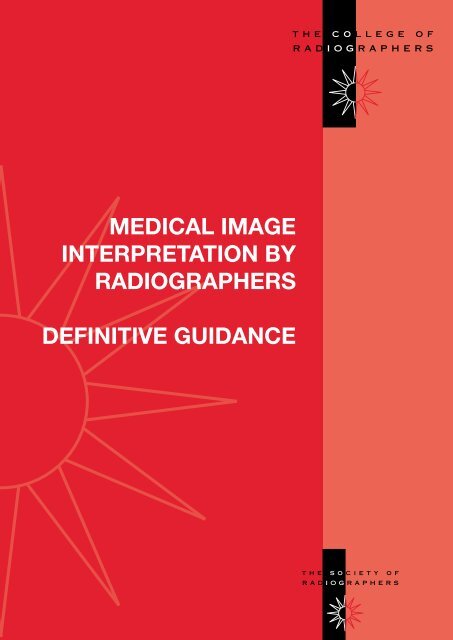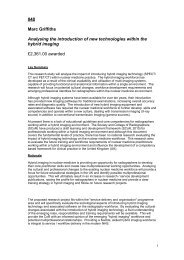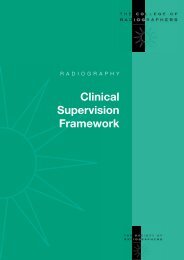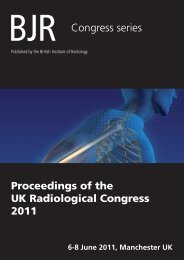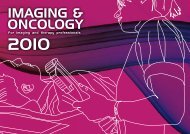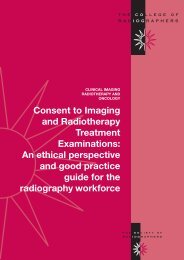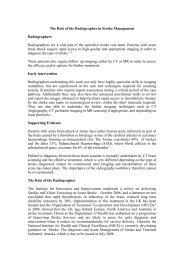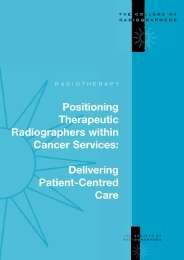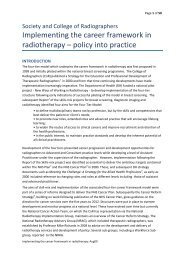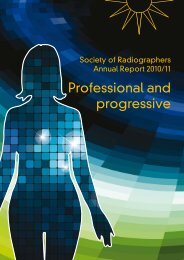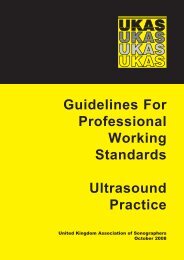Medical Image Interpretation by Radiographers: Definitive Guidance
Medical Image Interpretation by Radiographers: Definitive Guidance
Medical Image Interpretation by Radiographers: Definitive Guidance
You also want an ePaper? Increase the reach of your titles
YUMPU automatically turns print PDFs into web optimized ePapers that Google loves.
MEDICAL IMAGE<br />
INTERPRETATION BY<br />
RADIOGRAPHERS<br />
DEFINITIVE GUIDANCE<br />
1
<strong>Medical</strong> <strong>Image</strong> <strong>Interpretation</strong> <strong>by</strong> <strong>Radiographers</strong><br />
<strong>Definitive</strong> <strong>Guidance</strong><br />
College of <strong>Radiographers</strong>’ Responsible Officer:<br />
Audrey Paterson, Director of Professional Policy<br />
May 2010<br />
ISBN 9781 871101 68 9<br />
The Society of <strong>Radiographers</strong><br />
207 Providence Square<br />
Mill Street<br />
London SE1 2EW<br />
Telephone 020 7740 7200<br />
Facsimile 020 7740 7233<br />
E-mail info@sor.org<br />
Website www.sor.org<br />
3
Contents<br />
Foreword 5<br />
Introduction 6<br />
The Society and College of <strong>Radiographers</strong>’ Perspective 6<br />
<strong>Radiographers</strong>’ Education and Training in <strong>Medical</strong> <strong>Image</strong> Interpreation 7<br />
<strong>Radiographers</strong>’ Scope of Practice in <strong>Medical</strong> <strong>Image</strong> <strong>Interpretation</strong> 7<br />
Service Benefi ts from Radiographer Reporting 8<br />
Safety of Radiographer Reporting 8<br />
Conclusion 8<br />
References 9<br />
4
Foreword<br />
The publication <strong>by</strong> The Royal College of Radiologists (RCR) on the practice of radiographers in<br />
relation to medical image interpretation is disappointing on three counts.<br />
First, it has no business pronouncing on the roles and practice of radiographers; second, it is<br />
inaccurate, and, third, it is based on opinion rather than evidence. Indeed, it offers no evidence<br />
to support its view that employing reporting radiographers carries ‘substantially greater risks for<br />
healthcare organisations than employing radiologists’.<br />
I had hoped that the discussions in the two working group meetings convened <strong>by</strong> the RCR, and<br />
further discussion at the Clinical Radiology Faculty Board, would have discouraged the RCR from<br />
publishing its advice. Of course, it is entitled to publish its views but it is regrettable that these run<br />
contrary to the detailed and diffi cult work our respective organisations undertook jointly on team<br />
working 1 , which is so important to deliver the high quality, productive, effi cient and timely clinical<br />
imaging services needed in the UK.<br />
<strong>Radiographers</strong> are individually accountable healthcare practitioners regulated <strong>by</strong> the Health<br />
Professions Council. <strong>Medical</strong> image interpretation is legally and legitimately within the regulated<br />
practice of radiographers, and has been for many years.<br />
The Society and College of <strong>Radiographers</strong> (SCoR) is the professional body responsible for the<br />
scope of practice of radiographers. Accordingly, we are publishing this defi nitive guidance to<br />
provide assurance that radiographer reporting is safe, subject to reporting radiographers and<br />
their employers/contractors, adhering to our guidance. Further, it is important that healthcare<br />
organisations continue to develop and deploy reporting radiographers to continue to meet the<br />
current and future challenges of delivering comprehensive clinical imaging services in the UK.<br />
The SCoR will continue to work with The RCR to ensure that, together, our respective professions<br />
can deliver the high quality clinical imaging services so necessary to healthcare in the UK.<br />
Advanced and consultant practice radiographers, including those with medical image interpretation<br />
roles, are essential to such services.<br />
Gill Dolbear<br />
President<br />
The Society and College of <strong>Radiographers</strong><br />
1<br />
Team working within clinical imaging: a contemporary view of skills mix. The Royal College of Radiologists and The Society<br />
and College of <strong>Radiographers</strong>, January 2007.<br />
5
<strong>Medical</strong> <strong>Image</strong> <strong>Interpretation</strong> <strong>by</strong> <strong>Radiographers</strong>:<br />
<strong>Definitive</strong> <strong>Guidance</strong><br />
The Society and College of <strong>Radiographers</strong><br />
Introduction<br />
Advice on radiographers’ practice entitled <strong>Medical</strong> image interpretation <strong>by</strong> radiographers:<br />
<strong>Guidance</strong> for radiologists and healthcare providers has been issued recently <strong>by</strong> the Royal College<br />
of Radiologists (RCR) 1 . This outlines the RCR’s view on the conditions under which radiographers<br />
can undertake medical image reporting. The RCR’s guidance infers there are substantial risks for<br />
healthcare organisations in using professionals without medical qualifi cations to undertake medical<br />
image reporting, claiming that radiological diagnosis is included within the practice of medicine. It<br />
confi nes its guidance to radiographers only, taking no account of the fact that other non-medically<br />
qualifi ed groups also undertake medical image interpretation, including for example, nurse<br />
practitioners, midwives and physiotherapists 2,3,4 .<br />
The Society and College of <strong>Radiographers</strong> perspective<br />
The RCR is not the body that speaks for the radiography profession and it has no role in<br />
determining what is or is not appropriate practice for radiographers.<br />
The Society and College of <strong>Radiographers</strong> (SCoR) regrets that the RCR has issued its advice<br />
document on the practice of radiographers for several reasons:<br />
• <strong>Medical</strong> image interpretation <strong>by</strong> radiographers is well established 5 , with forty years of such<br />
practice in medical ultrasound imaging and twenty years in other fi elds of medical imaging.<br />
• The legal impediment to radiographers carrying out medical image interpretation was<br />
removed in the mid 1980s <strong>by</strong> the (then) statutory body for the radiography profession, the<br />
<strong>Radiographers</strong> Board at the Council for Professions Supplementary to Medicine 6 . The RCR<br />
held a seat on that Board and so was party to that decision.<br />
• In the past two decades, the contribution of radiographers to medical image interpretation has<br />
improved the volume of reporting undertaken and the speed at which reports are provided<br />
(report turn-around times), to the benefi t of referrers and patients alike 7 .<br />
• Research studies show consistently that reports made <strong>by</strong> properly trained reporting<br />
radiographers are concordant with reports of consultant radiologists, and are more accurate<br />
than those of non-radiological medical staff and other non-medical professionals 8-10 .<br />
• The description of radiographers’ education and training in medical image interpretation is<br />
both inaccurate and out of date.<br />
• The provision of defi nitive guidance on the practice of radiographers is the duty of the SCoR.<br />
In 2006, we issued our guidance 11 on reporting <strong>by</strong> radiographers in the document <strong>Medical</strong><br />
<strong>Image</strong> <strong>Interpretation</strong> & Clinical Reporting <strong>by</strong> Non-Radiologists: The Role of the Radiographer.<br />
The SCoR believes that the guidance issued <strong>by</strong> the RCR damages confi dence in the quality<br />
of clinical imaging services as they have been provided over many years, and may undermine<br />
future service development. Our view is that advanced practice radiographers are crucial to<br />
overcoming the challenges facing clinical imaging services in the future and, as the professional<br />
body responsible for the scope of practice of radiographers, we are publishing this document<br />
to provide assurance to healthcare providers that radiographer reporting is safe, subject to<br />
reporting radiographers and their employers/contractors, adhering to the guidance and standards<br />
of the SCoR 11-13 . Healthcare organisations need to deliver effective, timely clinical imaging and<br />
interventional services, and radiographers, including advanced and consultant practice reporting<br />
radiographers, are essential to doing so.<br />
6
<strong>Radiographers</strong>’ education and training in medical image interpretation<br />
<strong>Radiographers</strong> are regulated <strong>by</strong> the Health Professions Council (HPC) and must be registered<br />
with the HPC to practice in the UK. All pre-registration education and training programmes<br />
are approved <strong>by</strong> the HPC and must ensure that qualifying radiographers meet its standards of<br />
profi ciency 14 , and its standards of conduct, performance and ethics 15 . These standards provide the<br />
preparatory education and training necessary to support postgraduate development as advanced<br />
practice reporting radiographers and sonographers.<br />
To become an advanced practice reporting radiographer or sonographer, radiographers<br />
must complete postgraduate education and training programmes approved <strong>by</strong> the College of<br />
<strong>Radiographers</strong> (CoR) 16,17 . These programmes build on radiographers’ initial education and training,<br />
concentrating on developing clinical skills and knowledge of disease and trauma processes and<br />
manifestations; medical image interpretation theory and process, including errors; clinical history,<br />
signs and symptoms; previous and/or concurrent diagnostic information from imaging and/or<br />
laboratory tests, and multi-disciplinary consulting and communication 18,19 . All such programmes<br />
have considerable practise reporting components that must be supervised <strong>by</strong> a consultant<br />
radiologist or a very experienced, qualifi ed reporting radiographer, and programmes culminate<br />
in formal clinical examinations which must be passed. CoR approved programmes have been<br />
available since 1994, with consultant radiologists participating as faculty members, clinical mentors<br />
and external examiners.<br />
<strong>Radiographers</strong>’ scope of practice in medical image interpretation<br />
There are three critical elements to every diagnostic imaging examination:<br />
• It must be the appropriate investigation, justifi ed in the context of each person’s presenting<br />
signs and symptoms, and clinical history.<br />
• The examination needs to be timely and accurate to maximise the diagnostic potential of the<br />
investigation.<br />
• A report on the fi ndings of the examination must be the end point; this must be timely<br />
and communicated effectively to ensure it infl uences the individual’s subsequent clinical<br />
management. In 1995, the Audit Commission recommended that the majority of patients<br />
should leave the clinical imaging department with their reports 20 .<br />
<strong>Radiographers</strong>’ scope of practice spans all three of these critical elements, and they have been<br />
reporting on medical images for many years, beginning with ultrasound in the late 1960s/early<br />
1970s. In the past 20 years, radiographer reporting has extended into other modalities, including<br />
plain and contrast agent radiographic examinations, breast imaging, computed tomography<br />
(CT), magnetic resonance imaging (MRI) and nuclear medicine. <strong>Radiographers</strong> undertaking<br />
medical image interpretation do so within a defi ned scope of practice for which they have been<br />
educated, trained, assessed and deemed competent. A study in 2008, showed that reporting<br />
<strong>by</strong> radiographers in defi ned fi elds across the spectrum of clinical imaging was established prior<br />
to 2003 (the date of a previous survey), and had grown further since that date 5 ; and a report <strong>by</strong><br />
the (then) Health Care Commission in 2007 showed that radiographers were undertaking 16%<br />
of all reporting, with a further 10% of imaging procedures still unreported 7 . Evidently, therefore,<br />
radiographers make a signifi cant contribution to the reporting workload and, as a regulated allied<br />
health profession, they are directly accountable for their practice, including their reporting practice.<br />
7
Service benefits from radiographer reporting<br />
Reporting <strong>by</strong> advanced and consultant practice radiographers has led to service improvements<br />
for patients and referring clinicians. Generally, the volume of unreported imaging examinations has<br />
reduced, as has the time taken for a report to be returned to a referring clinician 7,21 . This has meant<br />
better compliance <strong>by</strong> healthcare providers with the requirements of the Ionising Radiation (<strong>Medical</strong><br />
Exposure) Regulations 2000; and provided referring clinicians with a report in time to inform the<br />
clinical management and treatment of their patients.<br />
Further service benefi ts are evident at national level. These include development of the NHS Breast<br />
Screening Programme to include double reporting of screening mammograms 22 ; this has only been<br />
possible because of advanced and consultant practice radiographers. The national stroke strategy<br />
is another example. This requires imaging and its subsequent interpretation to be undertaken<br />
very quickly after the onset of symptoms 23 . The availability of properly trained radiographers to<br />
perform and report on the scans is growing and is vital to the delivery of this national strategy. In<br />
relation to obstetric services, almost 70% of the required ultrasound investigations are undertaken<br />
and reported on <strong>by</strong> radiographers 24 , and they make signifi cant contributions to abdominal and<br />
gynaecological ultrasound scanning and reporting 25,26 .<br />
Safety of radiographer reporting<br />
The SCoR has always been clear in its demands that, in each of the fi elds in which they report,<br />
reporting radiographers must operate at the same standard as their clinical radiologist colleagues,<br />
and must demonstrate this at the point at which they complete their training and begin to<br />
practice 11 . They must also undertake regular audit and review and relevant CPD, and work within<br />
explicit clinical governance arrangements to ensure their practice remains at the required standard.<br />
The HPC requires radiographers to be and remain fully competent in their own scopes of practice,<br />
auditing the profession accordingly on a two-yearly cycle 27 .<br />
<strong>Radiographers</strong> that undertake reporting do so as a part of their specialist roles as advanced or<br />
consultant level practitioners. They are experienced individuals, practising at career framework<br />
levels 7 – 9 28 , and hold appropriate CoR approved postgraduate awards that underpin their<br />
practice, including reporting 16,17 .<br />
Research evidence underpins the safety of radiographer reporting and shows consistently that<br />
radiographers provide reports that are accurate, and concordant with reports of the same studies<br />
produced <strong>by</strong> consultant radiologists 8-10,25 .<br />
Conclusion<br />
The growth in radiographer reporting practice over the past four decades has been, and remains,<br />
necessary to deliver effective, timely clinical imaging services in the UK. Strong, underpinning<br />
education and proper governance processes provide assurance that the practice is safe. There<br />
is never room for complacency in relation to the safety of patients and it is vital that the two core<br />
professions responsible for delivering clinical imaging services work together to constantly improve<br />
those services. However, the SCoR has a duty to ensure that information provided to the public,<br />
healthcare providers and colleague professions on the practice of radiographers, including their<br />
reporting practice, is accurate and does not mislead.<br />
8
References<br />
1. The Royal College of Radiologists. <strong>Medical</strong> image interpretation <strong>by</strong> radiographers: <strong>Guidance</strong> for<br />
radiologists and healthcare providers. London: The Royal College of Radiologists, April 2010.<br />
2. Sakr M, Angus J, Perrin J, Nixon C, Nichol J, Wardrope J. Care of minor injuries <strong>by</strong> emergency<br />
nurse practitioners or junior doctors: a randomised controlled trial The Lancet 1999, Volume<br />
354, Issue 9187, Pages 1321-1326.<br />
3. Min Chen, Tak Yeung Leung, Daljit Singh Sahota, et al. Ultrasound screening for fetal structural<br />
abnormalities performed <strong>by</strong> trained midwives in the second trimester in a low risk population –<br />
an appraisal. Acta Obstetricia et Gynecologica Scandinavica 2009, Volume 88, Issue 6, Pages<br />
713-719.<br />
4. Jedrzejczak A, Chipchase L S. The availability and usage frequency of real time ultrasound <strong>by</strong><br />
physiotherapists in South Australia: an observational study. Physiotherapy Research International<br />
2008, Volume 13, Issue 4, Pages 231 – 240.<br />
5. University of Hertfordshire and The Institute for Employment Studies. Scope of Radiographic<br />
Practice 2008: A report compiled <strong>by</strong> the University of Hertfordshire in collaboration with the<br />
Institute for Employment Studies for the Society and College of <strong>Radiographers</strong>. University of<br />
Hertfordshire, 2009.<br />
6. Price R. Ultrasound: from pioneering to the present. Radiography 2010, Volume 16, Issue 2,<br />
Pages 91-92.<br />
7. Commission for Healthcare Audit and Inspection. An improving picture Imaging services in<br />
acute and specialist trusts. Commission for Healthcare Audit and Inspection, March 2007.<br />
8. Robinson P J A, Culpan D G, Wiggins M. <strong>Interpretation</strong> of selected accident and emergency<br />
radiographic examinations <strong>by</strong> radiographers: a review of 11,000 cases. The British Journal of<br />
Radiology 1999, Volume 72, Pages 546-551.<br />
9. Brealey S, Scally A, Hahn S, et al. Accuracy of radiographer plain radiograph reporting in clinical<br />
practice: a meta-analysis. Clinical Radiology 2005, Volume 60, Issue , Pages 232-241.<br />
10. Culpan D G, Mitchell A J, Hughes S, Nutman M, Chapman A H. Double contrast barium<br />
enema sensitivity: a comparison of studies <strong>by</strong> radiographers and radiologists. Clinical Radiology<br />
2002, Volume 57, Issue , Pages 604-607.<br />
11. The College of <strong>Radiographers</strong>. <strong>Medical</strong> <strong>Image</strong> <strong>Interpretation</strong> & Clinical Reporting <strong>by</strong> Non-<br />
Radiologists: The Role of the Radiographer. The College of <strong>Radiographers</strong>, September 2006.<br />
12. The College of <strong>Radiographers</strong>. Education and professional development: moving ahead. The<br />
College of <strong>Radiographers</strong>, January 2006.<br />
13. The College of <strong>Radiographers</strong>. Education and professional development strategy: new<br />
directions. The College of <strong>Radiographers</strong>, March 2010.<br />
14. Health Professions Council. Standards of profi ciency – radiographers. Health Professions<br />
Council, October 2009.<br />
15. Health Professions Council. Standards of conduct, performance and ethics. Health Professions<br />
Council, July 2009.<br />
16. The College of <strong>Radiographers</strong>. The Approval & Accreditation of Education Programmes &<br />
Professional Practice in Radiography: Policy & Principles. The College of <strong>Radiographers</strong>, April<br />
2004.<br />
9
17. The College of <strong>Radiographers</strong>. The Approval & Accreditation of Education Programmes &<br />
Professional Practice in Radiography: <strong>Guidance</strong> on Implementation of Policy and Principles.<br />
The College of <strong>Radiographers</strong>, September 2004.<br />
18. The College of <strong>Radiographers</strong>. A curriculum framework for radiography. The College of<br />
<strong>Radiographers</strong>, April 2003.<br />
19. The College of <strong>Radiographers</strong>. Learning and development framework for clinical imaging and<br />
oncology. The College of <strong>Radiographers</strong>, February 2008.<br />
20. The Audit Commission. Improving your image – how to manage radiology services more<br />
effectively. London: HMSO, 1995.<br />
21. Piper K. Implementation of a radiographic reporting service in 4 NHS Trusts: fi nal report for<br />
South Thames NHSE, April 1999. www.canterbury.ac.uk/health/allied-health-professions/<br />
documents/NHSReport.pdf (accessed 07.05.2010)<br />
22. Advisory Committee on Breast Cancer Screening. Screening for breast cancer in England: past<br />
and future. NHS Cancer Screening Programmes, 2006.<br />
23. Department of Health. National stroke strategy. Department of Health, December 2007.<br />
24. NHS Fetal Anomaly Screening Programme. Ultrasound Survey of England 2008 - Mapping of<br />
fi rst and second trimester fetal screening services in the UK. NHS Fetal Anomaly Screening<br />
Programme, April 2010.<br />
25. Leslie A, Lockyer H, Virjee JP. Who should perform routine abdominal ultrasound A<br />
prospective blind study comparing the accuracy of radiologist and radiographer. Clinical<br />
Radiology 2000, Volume 55, pages 606-608.<br />
26. Nicol M. Reporting on gynaecological ultrasound. Synergy: Imaging and Therapy Practice,<br />
June 2009.<br />
27. Health Professions Council. Continuing professional development and your registration. Health<br />
Professions Council, February 2010.<br />
28. Department of Health. Modernising allied health professions careers: a competence based<br />
career framework. Department of Health, July 2008.<br />
10
The College of <strong>Radiographers</strong><br />
Limited company registration number 1287383<br />
Registered charity number 272505<br />
ISBN 9781 871101 68 9<br />
The Society of <strong>Radiographers</strong><br />
207 Providence Square<br />
Mill Street<br />
London SE1 2EW<br />
12<br />
Telephone 020 7740 7200<br />
Facsimile 020 7740 7233<br />
E-mail info@sor.org<br />
Website www.sor.org


